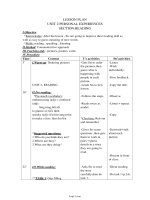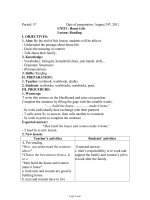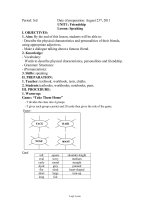Bài soạn môn học Tiếng Anh 11 - Unit 14: Recreation - Lesson 5: Language focus
Bạn đang xem bản rút gọn của tài liệu. Xem và tải ngay bản đầy đủ của tài liệu tại đây (149.54 KB, 6 trang )
<span class='text_page_counter'>(1)</span>Designed by: Luu Nguyen (Ms.) Group: 061E4 University of Languages and International Studies Vietnam National University, Hanoi Email address: LESSON PLAN UNIT 14: recreation Lesson 5: language focus. I.. Aims:. - Teaching Ss how to pronounce the sounds /ts/, /dz/, /t t/, and /d d/ - Teaching Ss how to use paired conjunctions both…and, not only…but also, either…or, neither…nor - Teaching Ss how to make cleft sentences in the passive II.. Objectives:. During and after the lesson, Ss will be able to: - Pronounce the sounds /ts/, /dz/, /t t/, and /d / correctly - Use paired conjunctions both…and, not only…but also, either…or, neither…nor correctly and appropriately - Make cleft sentences in the passive correctly and appropriately III.. Teaching aids:. Textbook, chalk, blackboard, handouts IV.. Anticipated problems and back-up plan. - There may be a lack of time, so T should be careful, and T should give Ss some more exercises to practice at home. V. Procedure Stages Warm-up. Time Teacher’s activities 5’ - Aim: to lead Ss to the lesson. Students’ activities - Play the game. 1 Lop11.com.
<span class='text_page_counter'>(2)</span> - Introduces the game: crossword. Try to find out the words based on the clues given:. + 5 letters, shoes that cover the feet and ankles, and sometimes also the lower legs boots + 4 letters, children kids + 7 letters, looked at SBD carefully for a period of time watched + 7 letters, became or made SBD/ST different changed B K W C. Pronunciation. 15’. O I A H. O D T A. T S C N. S H G. E E. D D. - Asks Ss to read the words out - Leads Ss to the lesson: learn how to pronounce the sounds /ts/, /dz/, /t t/, and /d d/ - Instructs Ss to pronounce each sound * /ts/: + Tells Ss that first, we pronounce /t/ then move quickly to /s/ + Pronounces /ts/ as a model + Calls Ss to pronounce /ts/ + Asks Ss to read the words with /ts/ in the textbook: sits, eats, meets + Calls some Ss to read the words out. * /dz/: + Tells Ss that first, we pronounce /d/ then move quickly to /z/ + Pronounces /dz/ as a model + Calls Ss to pronounce /dz/ + Asks Ss to read the words with /dz/ in the textbook: reads, friends, kids + Calls some Ss to read the words out. * /t t/: + Tells Ss that first, we pronounce /t / then move quickly to /t/ + Pronounces /t t/ as a model. - Read the words out - Listen to T’s lead-in. - Do what they are required to do: + Listen to T, asks questions if any + Listen to T + Pronounce /ts/ if asked + Reads the words + Read the words if asked + Listen to T, asks questions if any + Listen to T + Pronounce /dz/ if asked + Reads the words + Read the words if asked + Listen to T, asks questions if any + Listen to T + Pronounce /t t/ if asked 2. Lop11.com.
<span class='text_page_counter'>(3)</span> + Calls Ss to pronounce /t t/ + Reads the words + Asks Ss to read the words with /dz/ in the textbook: marched, watched, reached + Read the words if asked + Calls some Ss to read the words out + Listen to T, asks questions * /d d/: if any + Tells Ss that first, we pronounce + Listen to T /d / then move quickly to /d/ + Pronounce /d d/ if asked + Pronounces /d d/ as a model + Reads the words + Calls Ss to pronounce /d d/ + Asks Ss to read the words with /d d/ in the textbook: bridged, raged, + Read the words if asked managed + Calls some Ss to read the words out. Grammar. 25’. - Instructs Ss to practice reading aloud the sentences in the textbook. + Listen to T. + Reads the sentences first, points out the words that contain the sounds just learnt. + Asks Ss to read aloud the sentences + Listens and gives comments. + Read the sentences aloud + Listen to T’s comments. 1. Both…and - T says “I like listening to music. Do you like listening to music?” - T says “I like listening to music. You like listening to music, too.” Asks Ss how to change the two sentences into one? - T says: Very good! You see, we use both…and to join similar elements between sentences. The elements can be nouns, pronouns, verbs, adj, and adv. Now, try to make more sentences with both…and. - Listens and gives comments - Asks Ss to put be in Both my mother and my father (be) teachers into the correct form. (answer: are) - Tells Ss that with both…and, the verb is in the plural form.. - Answer “Yes” - Answer “Both you and I like listening to music.” - Listen, then make sentences with both…and.. - Listen to T’s comments - Put be in the correct form - Listen and take notes. 3 Lop11.com.
<span class='text_page_counter'>(4)</span> 2. Not only…but also - Shows Ss a 10,000 VND note, and asks Ss to name two things they can buy with that amount of money. - Expected answers: a notebook, a postcard. - Says “With this 10,000 VND you can buy both a notebook and a postcard. Or we can say: With this money we can buy not only a notebook but also a postcard.” - Points out that not only…but also is to add extra information - Asks Ss to make sentences with not only…but also - Listens and gives comments - Asks Ss to put the verb in Not only my mother but my father also (like) cooking in the correct form. - Tells Ss that with not only…but also, the second subject determines the verb.. - Name two things that can be bought with 10,000 VND - Listen to T. - Listen, take notes - Make sentences with not only…but also - Listen to T’s comments - Put the verb like in the correct form. - Listen, take notes. 3. Either…or - Says “Name two things that you can buy only one of them with this 10,000 VND.” - Expected answers: a 10,000 VND prepaid phone card, & a 7,000 VND glass of milk. - Says “So, with 10,000d, you can buy either a 10,000 prepaid phone card or a 7,000 glass of milk.” Points out that either…or: + describes a situation in which there is a choice between two things, but both together are not possible. + can join pronouns, nouns, verbs, etc. (similar elements). - Asks Ss to make sentences with. - Name two things they can buy only one of them with this 10,000 VND. - Listen to T. - Listen to T, take notes. - Make sentences with 4. Lop11.com.
<span class='text_page_counter'>(5)</span> either…or - Listens and gives comments - Asks Ss to put “be” in Either an apple or an orange (be) ok in the correct form. (answer: is) - Tells Ss that with either…or, the second object determines the verb.. either…or - Listen to T’s comments - Put “be” in the given sentence in the correct form. - Listen, take notes. 4. Neither…nor - Says “Again, with 10k VND, can we buy a pair of jeans, or a new dictionary?” - Says “That’s right. With 10k VND, we can’t buy a new pair of jeans. We can’t buy a new dictionary, either.” - Asks Ss how to change the two sentences into one. With 10k VND, we can buy neither a new pair of jeans nor a new dictionary.” - Points out that neither…nor is to join two negative ideas. - Asks Ss to makes sentences with neither…nor. - Listens and gives comments - Asks Ss to put the verb be in Neither I nor she (be) a student in the correct form. (answer: is) - Points out that with neither…nor the second subject determines the verb.. - Answer “No” - Listen to T - Change the two into one. - Listen to T - Make sentences with neither…nor - Listen to T’s comments - Put be in the given sentence in the correct form - Listen, take notes. 5. Cleft sentences in the passive - Asks Ss to change Mr. Long - Change the given teaches English at Xuan Dinh high sentence into a cleft school into a cleft sentence. sentence. - Correct answer: It is English that Mr. Long teaches at XD high school. - Asks Ss whether they know - Tell T if they know 5 Lop11.com.
<span class='text_page_counter'>(6)</span> another way to do that. - Tells Ss the other way: It is English that is taught by Mr. Long at XD high school. - Tells Ss that it is a cleft sentence in the passive. - Asks Ss to work out the structure. - Write the structure on the board It + (be) + focus + that + be + V. pp +… - Asks Ss to change some sentences into cleft sentences in the passive. + The boy hit the dog in the garden yesterday. + His appearance frightened the children. + The president makes the important decisions.. - Listen, take notes. - Listen, take notes - Work out the structure - Take notes - Change the given sentences into cleft sentences in the passive. - Key: + It was the dog that was hit in the garden. + It was the children that were frightened by his appearance. + It is the important decisions that are made by the president.. Homework. 1’. Asks Ss to do exercises 1, 2 pages 161, 162 in the textbook.. - Listen, ask questions if any. 6 Lop11.com.
<span class='text_page_counter'>(7)</span>









